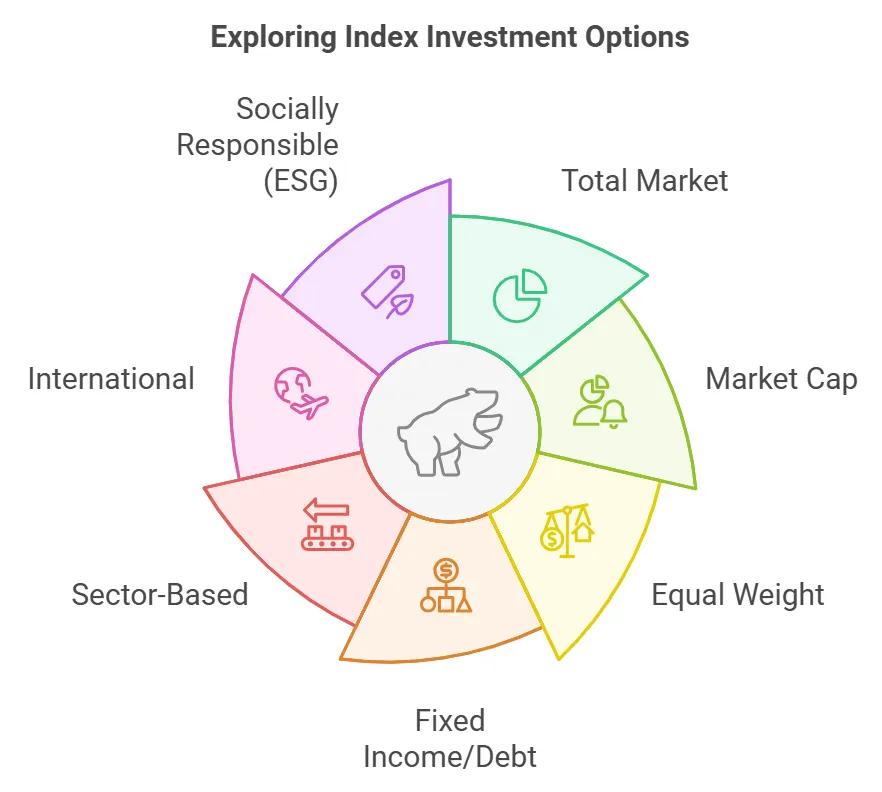Take the Blindfold Off: A Guide to 7 Different Categories of Index Investments
Investing can feel like a confusing game with complicated rules. You hear whispers of hot stocks and whispers of market crashes, leaving you wondering where to even begin. What if there was a way to invest in the entire market, or a specific industry, all without needing a crystal ball?
The Problem: Picking Stocks is Like Playing Darts Blindfolded
Imagine you're at a dartboard, blindfolded, with someone shouting random stock names. That's what picking individual stocks can feel like. You might hit a bullseye occasionally, but it's mostly luck. Financial advisors are great, but their fees can add up. There’s a better way!
The Solution: Enter the Index Fund Feast
Index funds are like a delicious buffet at a fancy restaurant. Instead of picking one mystery dish, you get a little bit of everything. An index fund tracks a specific market segment, like the S&P 500, which holds a basket of companies. This means you instantly own a slice of all those companies, without needing to research each one.
Index Funds vs. ETFs: What's the Difference?
Both index funds and exchange-traded funds (ETFs) are excellent options for investors seeking diversification and a hands-off approach. However, there are some key differences:
- Structure: Index funds are typically mutual funds, meaning they hold shares of underlying investments and you purchase shares directly from the fund company. ETFs trade on stock exchanges like stocks, offering more flexibility for buying and selling throughout the day.
- Trading Fees: Mutual funds often have minimum investment requirements and may charge sales loads (fees for buying shares). ETFs generally have lower fees and no minimums.

Choosing Your Flavor: A World of Index Funds (and ETFs) Awaits
The beauty of index funds and ETFs is the variety! Let's explore some, along with some popular examples:
1. Total Market: Craving a taste of the entire US stock market? This type of fund gives you a slice of the whole pie.
Examples:
2. Market Cap: These funds come in different sizes, focusing on established giants (large-cap), growing companies with potential (mid-cap), or future superstars (small-cap).
Examples:
- Large-Cap: Fidelity 500 Index Fund (FXAIX) or SPDR S&P 500 ETF (SPY)
- Mid-Cap: Vanguard Mid-Cap Index Fund (VO) or iShares Core S&P Mid-Cap ETF (MDY)
- Small-Cap: iShares Russell 2000 Index Fund (IWM) or Vanguard Small-Cap ETF (VB)
3. Equal Weight: Tired of big companies hogging the spotlight? These funds give all the holdings in the basket an equal weight, ensuring a more balanced plate.
Example: Invesco S&P 500 Equal Weight ETF (RSP)
4. Fixed Income/Debt: Think of these as a basket of bonds, offering stability to your portfolio, like a side dish of mashed potatoes at your investment feast.
Examples:
- Vanguard Total Bond Market Index Fund (VBLAX)
- iShares Core U.S. Aggregate Bond ETF (AGG)
- PIMCO Active Bond Exchange-Traded Fund (BOND) (BOND)
5. Sector-Based: Got a favorite industry, like tech or healthcare? These funds let you focus your investment on a specific sector, like picking your favorite entree.
Examples:
- Vanguard Information Technology Index Fund ETF Shares (VGT) or SPDR Technology elect Sector Fund ETF (XLK)
- Healthcare: Fidelity Health Care Sector Index Fund (FHLCX) or Health Care Select Sector SPDR Fund (XLV)*
6. International: The world awaits! These funds provide exposure to stocks outside the US, letting you diversify your portfolio globally.
Examples:
- Vanguard Total International Stock Index Fund (VTIAX)
- iShares Core MSCI International Stock ETF (IXUS)
7. Socially Responsible (ESG): Want to align your investments with your values? ESG funds focus on companies with strong environmental, social, and governance practices, letting you invest with a conscience.
Examples:
Finding Your Perfect Plate: Start Simple, Then Explore
New to investing? A total market fund is your best bet. It's diverse, affordable, and lets you take a hands-off approach. As you gain experience, you can explore other flavors to personalize your portfolio and match your investment goals.
Remember, when selecting an Index fund or an Index ETF, do your research. Ask…
- Does it fit with my investment goal?
- Does it have a sound performance record?
- Is the Expense Ratio appropriate.

